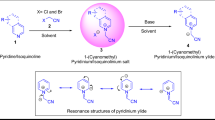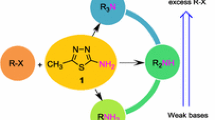Abstract
2-Ketoindoline and 1-methyl-2-ketoindoline condense with hydroxymethylene ketones in the presence of hydrogen chloride to give pyrylium[2,3-b]indole chlorides, which can be converted to 5-(3-oxindolyl)-Δ2-pyrazolines by reaction with phenylhydrazine and to 5-(3-oxindolyl)-Δ2-isoxazolines by reaction with hydroxylamine.
Similar content being viewed by others
Literature cited
G. N. Dorofeenko, G. V. Lazur'evskii, and G. I. Zhungietu, Dokl. Akad. Nauk SSSR, 161, 355 (1965).
J. Bourdais, Tet. Letters, 2895 (1970).
A. T. Balaban, G. Mateescu, and M. Elian, Tetrahedron, 18, 1083 (1962).
J. A. Durden and D. G. Grosby, J. Org. Chem., 30, 1684 (1965).
K. Dimroth, Angew.Chem., 72, 331 (1960).
Dictionary of Organic Compounds, Oxford University Press (1966).
Author information
Authors and Affiliations
Additional information
Translated from Khimiya Geterotsiklicheskikh Soedinenii, No. 8, pp. 1030–1032, August, 1972.
Rights and permissions
About this article
Cite this article
Zhungietu, G.I., Sukhanyuk, B.P. Pyrylium[2,3-b]indole salts. Chem Heterocycl Compd 8, 932–934 (1972). https://doi.org/10.1007/BF00476316
Received:
Issue Date:
DOI: https://doi.org/10.1007/BF00476316




